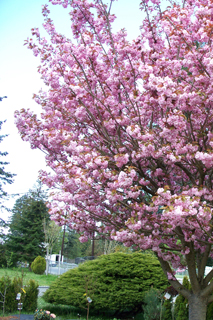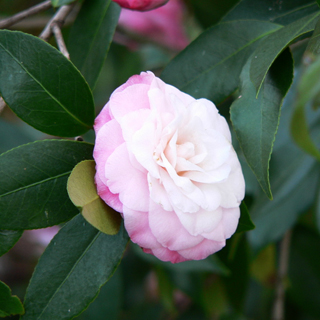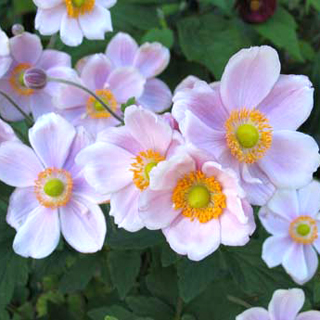 Life in the garden is returning to normal. A few dry days and I can hear the steady of hum of lawn mowers, strimmers and hedge trimmers. The swallows have returned and birds are nesting so leave any hedges now until the babies have fledged.
Life in the garden is returning to normal. A few dry days and I can hear the steady of hum of lawn mowers, strimmers and hedge trimmers. The swallows have returned and birds are nesting so leave any hedges now until the babies have fledged.
If you really have to cut something then now is the time to look at ornamental flowering cherries. I was reminded of this both by my errant cherry about which more shortly, and also by the recent visit to Veryan of two old friends who left Veryan a few years back, Graeme and Brenda. Before they left Veryan, Graeme very kindly gave me a lawn mower which he didn’t want to take with him and I often go to the shed, get her out, (she starts first time) and say ‘come on Brenda we have lawns to cut.’ What a legacy having a lawn mower named after you!
 But I was also reminded of Brenda asking me when to prune the ornamental cherry trees. I don’t know why this has stuck in my mind, possibly because I had not long planted one before we had the conversation or more likely that I was astonished to be asked for advice by one of the most competent and knowledgeable gardeners I have ever met! Mine is a small weeping variety, a beautiful pink and it has grown substantially.
But I was also reminded of Brenda asking me when to prune the ornamental cherry trees. I don’t know why this has stuck in my mind, possibly because I had not long planted one before we had the conversation or more likely that I was astonished to be asked for advice by one of the most competent and knowledgeable gardeners I have ever met! Mine is a small weeping variety, a beautiful pink and it has grown substantially.
Most ornamental cherries are grafted so you can see a big nobble at the top of the trunk and that’s where a slow growing root stock has been grafted onto the ornamental top. If you let any branches grow beneath the graft then they tend to be typical of one of the parents of the root stock and may not weep but become very upright or overly strong and spoil the look of the tree. Equally some of the weeping branches can soon touch the floor or cross over each other and damage the bark in the wind.
 Now is absolutely the right time to trim up the tree to the shape you require. Once the blossoms have gone over and the new leaves are there, this is the time to cut and will avoid any disease taking hold particularly silver leaf which is unsightly and very damaging. The same treatment applies now to camellias and forsythia and anything that has flowered. Trim now and you will not spoil next year’s buds which are getting ready to form. So I shall carefully trim those branches that are crossing over each other or rubbing against another branch or are not showing signs of weeping.
Now is absolutely the right time to trim up the tree to the shape you require. Once the blossoms have gone over and the new leaves are there, this is the time to cut and will avoid any disease taking hold particularly silver leaf which is unsightly and very damaging. The same treatment applies now to camellias and forsythia and anything that has flowered. Trim now and you will not spoil next year’s buds which are getting ready to form. So I shall carefully trim those branches that are crossing over each other or rubbing against another branch or are not showing signs of weeping.
I always plant my runner beans in pots at the beginning of May. I get them going in 4”pots in the tunnel ready for hardening off 3 weeks later and planting into the ground at the end of May. It is perfectly acceptable to plant the beans straight into the ground towards the end of the month but I then risk the mice finding them. Also this month I shall be planting out onions that I have grown inside from seed and lettuces. The new potatoes started to emerge quickly in the sunshine and so they are being regularly earthed up to increase the yield.
 I am following my usual rule of growing vegetables that are more expensive in the shops or those that just taste better when picked really fresh, hence different types of beans, sweet corn and we are already enjoying a few asparagus spears.
I am following my usual rule of growing vegetables that are more expensive in the shops or those that just taste better when picked really fresh, hence different types of beans, sweet corn and we are already enjoying a few asparagus spears.
In the flower borders I am regularly tackling weeds but they are diminishing in beds where I have kept good soil coverage. Perennial planting and the emergence of day lilies, allium and the good cover of agapanthus tends to keep the soil covered and deter the weeds or prevent seed getting in. This is not the case in the herbaceous border. These are the plants that come up every year, flower and then die down. As they emerge the weeds come with them and it is a fairly constant and thankless task trying to keep them in check.
But I have not given up with the herbaceous border. There is something very satisfying about seeing these plants re-emerge and I am so glad that I planted so many more last autumn. Gardening is very much about planning ahead. But for those who have not planned ahead at least you can buy plants now that are emerging in the pots, you can see what you are likely to achieve from the growth now. Get them in and for a few quid you have plants that last for years.
 I have been interested to see which plants really enjoyed the winter. It was not as wet as last year but there was enough rain and certainly the trees and hedges enjoyed the water, so too the camellias. Very little seems to have been adversely affected by last winter and I am amazed by the growth on the Japanese anemones which are coming up much more strongly than they have ever done, they have spread widely and look very healthy indeed, this must be the unseasonably warm weather recently.
I have been interested to see which plants really enjoyed the winter. It was not as wet as last year but there was enough rain and certainly the trees and hedges enjoyed the water, so too the camellias. Very little seems to have been adversely affected by last winter and I am amazed by the growth on the Japanese anemones which are coming up much more strongly than they have ever done, they have spread widely and look very healthy indeed, this must be the unseasonably warm weather recently.
The drier weather gave me an opportunity to scarify my lawn. I have a small rotovator, light as a feather, which has an option to attach tines which scarify the lawn quickly. This takes out all the dead thatch and as always I was amazed just how much dead grass there is. I raked it all up and the lawn initially looks dreadful but with a feed and some drizzle it was looking much healthier in a week or so.
 Now I am not desperately keen on lawns or their constant maintenance. I think that we have so many huge patches of unkempt and uncared for grass that there is always something more interesting to grow. I begrudge spending too much time or effort but I have to say that when you see the perfect swards of turf that many achieve it does provoke an element of lawn envy. My friend Mr Grigg works so hard on his lawns in Veryan, they are the envy of everyone but his lawn is this good because of the work he puts in.
Now I am not desperately keen on lawns or their constant maintenance. I think that we have so many huge patches of unkempt and uncared for grass that there is always something more interesting to grow. I begrudge spending too much time or effort but I have to say that when you see the perfect swards of turf that many achieve it does provoke an element of lawn envy. My friend Mr Grigg works so hard on his lawns in Veryan, they are the envy of everyone but his lawn is this good because of the work he puts in.
So when he arrived in my drive last season I had the opportunity to ask his advice. ‘What should I treat the lawn with Gilbert to get it looking as good as yours?’ (I am very reluctant to succumb to these weed and feed concoctions which are overpriced and over hyped, in my opinion.)’ Lawn sand will do it’ he said confidently. ‘A shame really,’ I replied, ‘the daisies look so pretty.’ And his response? ‘So make a daisy chain and hang yourself with it!’ Bless him, with friends like that…
Nicola Bush

